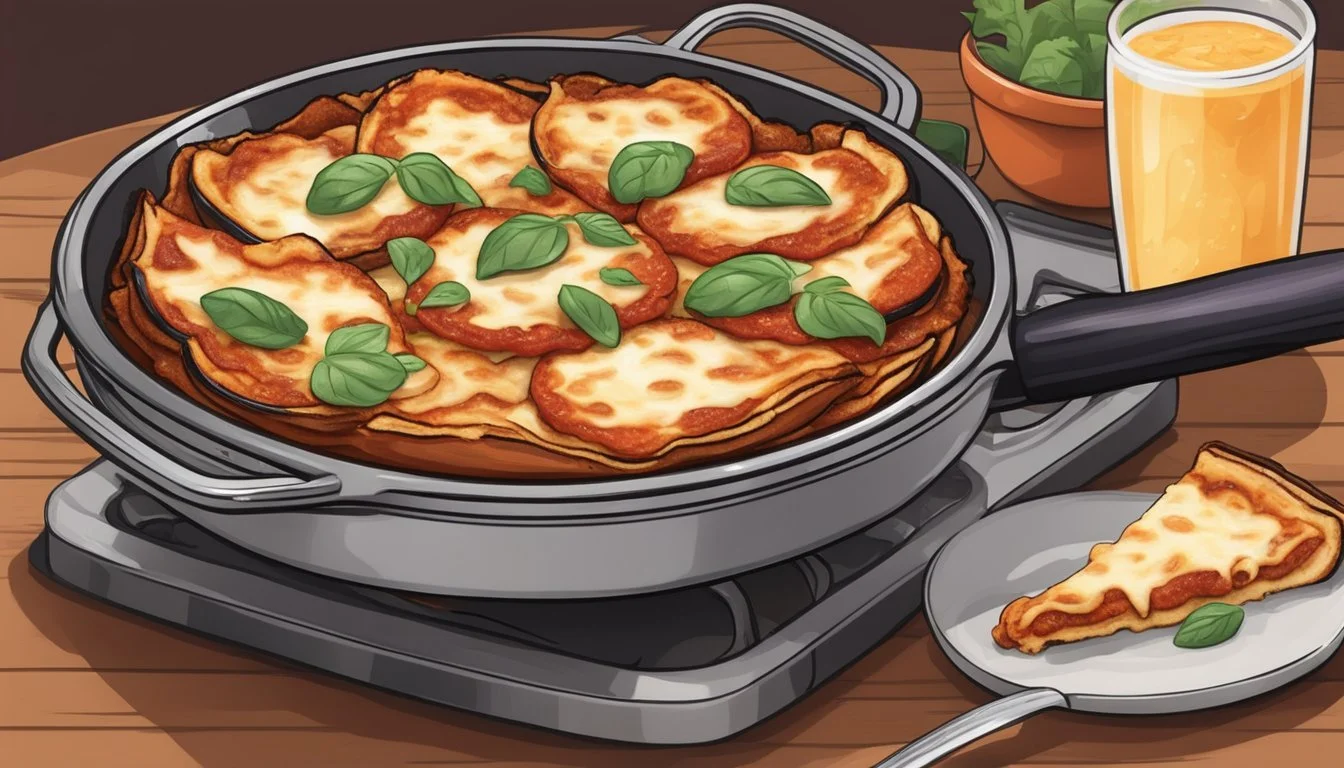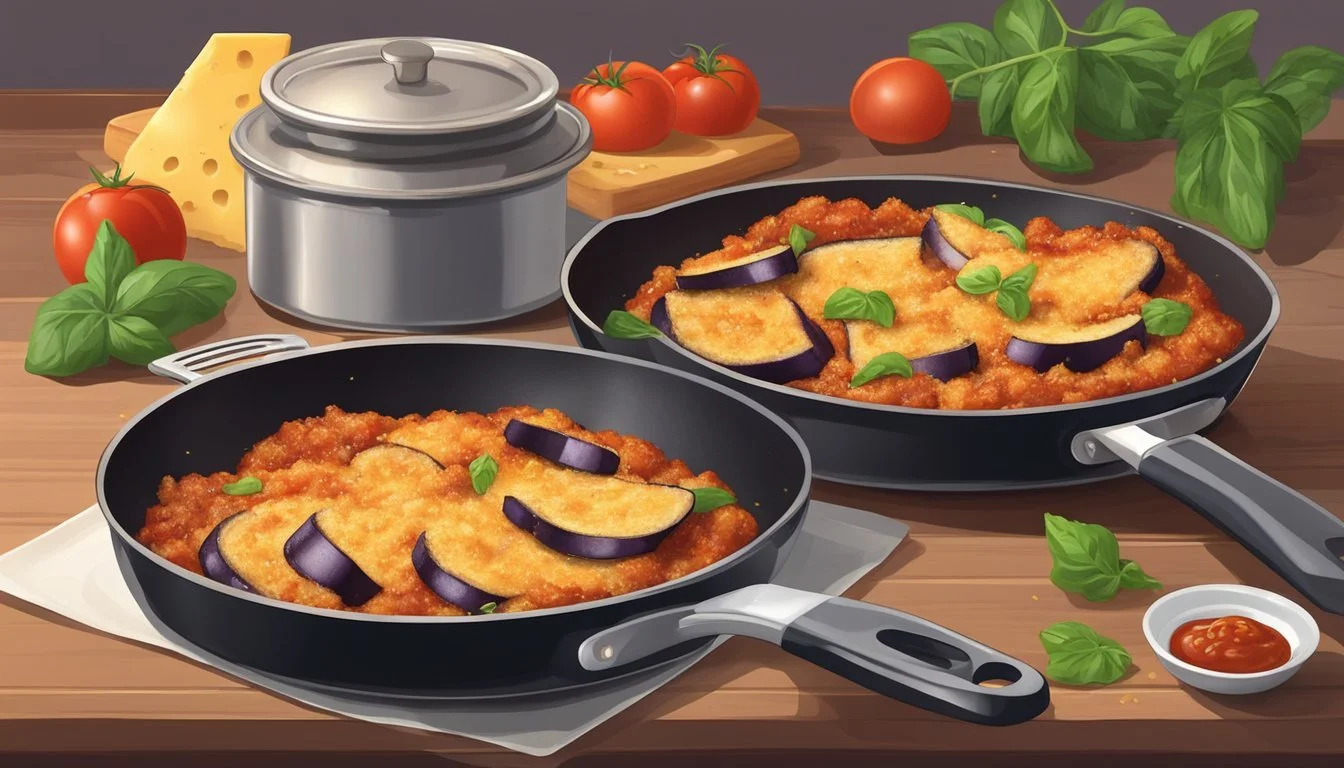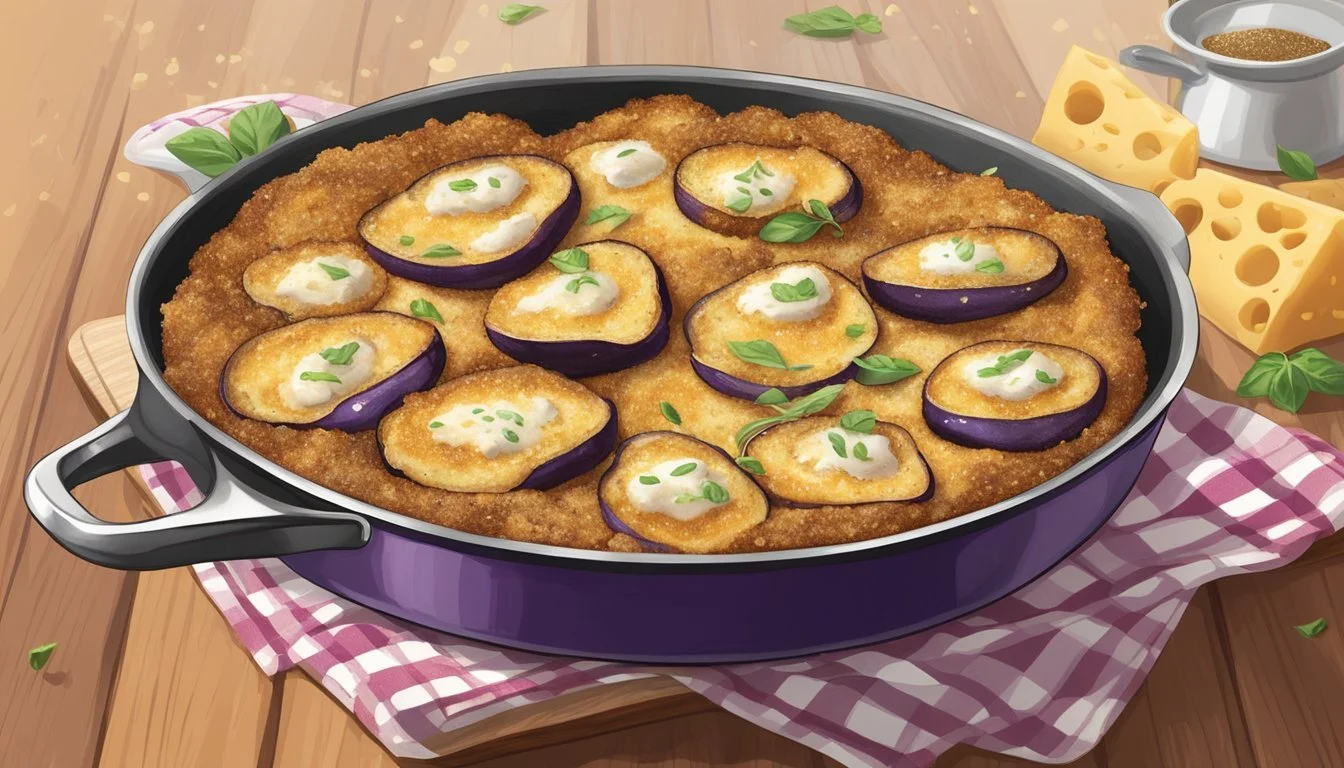The Oven-Less Eggplant Parmesan
A Stovetop Method for Crispy, Cheesy Perfection
Eggplant Parmesan (What wine goes well with eggplant parmesan?) is a beloved comfort food classic, traditionally featuring layers of crispy breaded eggplant (What wine goes well with eggplant?) slices, rich tomato sauce, and gooey melted cheese. However, the conventional method of preparing this dish typically requires a significant amount of oil for frying, followed by further baking in the oven, which can be time-consuming and not suited for low-carb diets. To address these concerns, culinary enthusiasts have developed a stovetop method that doesn't compromise on the coveted crispiness but does away with the need for an oven and reduces the carb content.
By taking the dish to the stovetop, cooks can achieve a crispy texture on the eggplant by using alternative low-carb coatings and careful pan-frying techniques. This version appeals to those looking to enjoy a healthier variant of the classic, as it simultaneously lowers the carbohydrate impact and maintains the essential flavors of the dish. The result is a satisfyingly crispy eggplant Parmesan that remains true to its roots in taste and texture, while aligning with dietary preferences that lean toward lower carb intake.
Care must be taken to ensure that the eggplant slices are cooked to achieve a golden-brown exterior without becoming soggy, a balance that is central to the success of the dish. Cheeses are chosen for their ability to melt beautifully and envelop the eggplant in a creamy embrace, which further lends the dish its characteristic comfort feel. This stovetop approach to eggplant Parmesan showcases the versatility and adaptability of classic recipes to modern cooking techniques and nutritional considerations, making it accessible to a wider range of diners while upholding the essential experience of the traditional meal.
Exploring Eggplant
In the world of veggies, eggplant holds a unique place, offering a versatile base for a variety of dishes. Understanding how to select and prepare eggplant paves the way for a successful, crispy, and cheesy stove-top Eggplant Parmesan.
Selecting Quality Eggplant
When choosing eggplants, one should look for a firm, glossy exterior free of blemishes. The stem should be bright green, indicating freshness. A quick test for ripeness is gentle pressure on the skin; it should bounce back if ripe. Smaller eggplants tend to have thinner skin and less seeds, resulting in a sweeter taste and more tender texture.
Size and Color:
Small to medium
Deep purple
Feel:
Firm
Smooth
Look:
Glossy
No wrinkles or brown spots
Stem:
Green
Preparation Techniques
Preparation is critical for stove-top Eggplant Parmesan. Start by slicing the eggplant into uniform thickness, approximately 1/2 inch rounds, to ensure even cooking. For a less bitter taste, salt the slices and allow them to "sweat" in a colander for 30 minutes to an hour; this draws out excess moisture and bitterness. Rinse the salt off and pat the eggplant dry. Before cooking, create a coating for the eggplant to achieve that desired crispiness.
Slicing:
Uniform 1/2-inch rounds
Salting:
Generous with kosher salt
30 to 60 minutes of "sweating"
Coating:
Panko breadcrumbs or Italian breadcrumbs
For the best results, properly seasoned and crumb-coated eggplant slices are pan-fried until golden brown, which not only imparts a desirable texture but also a depth of flavor that's quintessentially Eggplant Parmesan—minus the oven.
Stovetop Cooking Method
Cooking eggplant parmesan on the stovetop allows for a crispy exterior without the need for an oven. Careful management of temperature and safety practices ensure a delightful result.
Achieving Crispiness
To achieve a crispy texture, one should heat oil in a skillet over medium heat. The eggplant slices, previously breaded, are then added to the hot oil. It's critical to cook them for about 3 to 5 minutes on each side until they reach a golden-brown color. The breading should consist of a mixture of panko breadcrumbs and grated parmesan, which contributes to the crispiness.
Key Points for Crispiness:
Use panko breadcrumbs and grated parmesan for the breading.
Fry breaded eggplant slices for 3-5 minutes on each side.
Controlling Temperature
Controlling the temperature is essential for cooking eggplant parmesan on the stovetop. The ideal range lies between medium-low to medium heat. This ensures that the eggplant cooks evenly without burning. One must monitor the skillet's temperature carefully – a heat that's too low may result in soggy eggplant, while too high can burn the breading before the eggplant is cooked through.
Ideal Temperature Range: Medium-low to medium heat
Safety Tips While Cooking
When cooking with hot oil, safety is paramount. The cook should never leave the skillet unattended and should use a splatter screen to protect against oil splatters. It is also advisable to have a kitchen fire extinguisher accessible and to use oven mitts when handling the skillet.
Prevent Oil Splatters: Use a splatter screen.
Handle Hot Skillet Safely: Use oven mitts.
Be Prepared for Emergencies: Keep a kitchen fire extinguisher within reach.
Layering Flavors
Layering flavors is crucial in creating an eggplant parmesan that sings with complexity and depth. One must consider the type of cheeses, the aromatic impact of herbs and spices, and the way sauces can either make or break this symphony of flavors on the palate.
Choosing the Right Cheeses
The cheese one selects is the backbone of eggplant parmesan's richness. A blend of mozzarella and Parmesan cheeses is traditional, providing a satisfying melt and a salty, umami punch. However, introducing cream cheese can add an unexpected creaminess and help to bind the layers together. To ensure even melting, one should thinly slice or grate the cheeses.
Herbs and Spices
For an aromatic lift, fresh basil and oregano are indispensable in eggplant parmesan. These herbs bring a fragrant note that complements the creamy cheese. A generous seasoning of ground black pepper not only adds heat but also enhances the other flavors, underpinning the dish with a subtle earthiness.
Creating Balance with Sauces
The sauce acts as a flavor mediator, enveloping the eggplant and cheese in a rich, tomato-based embrace. Utilizing a combination of marinara and alfredo sauces can create a nuanced profile. For a bold twist, whisking in a touch of mustard can introduce a tangy element that cuts through the richness, homogenizing the layers into a cohesive dish. The proper sauce consistency is vital; it should be thick enough to cloak but not so heavy as to saturate and overwhelm.
Serving and Pairing
When serving stove-top eggplant parmesan, complementing the dish with the right side and drink enhances the dining experience. Thoughtfully paired sides and drinks can elevate the meal's flavors.
Accompanying Side Dishes
Stove-top eggplant parmesan carries a hearty and rich flavor profile, which pairs well with light and refreshing side dishes. A well-paired side dish not only balances the meal but also adds a textural contrast to the crispy, cheesy eggplant.
Simple green salad: A salad dressed with a vinaigrette provides a crisp counterpoint.
Steamed vegetables: Broccoli or green beans, seasoned with a touch of garlic and lemon zest, complement the flavors without overwhelming them.
Garlic bread: For those who prefer a more indulgent accompaniment, garlic bread serves as a savory sponge for the tomato sauce.
Recommended Drink Pairings
The choice of drink can either cut through the richness of the cheese or complement the savory notes of the tomato sauce.
Cocktails:
Aperol Spritz: Its bubbly and slightly bitter profile cleanses the palate.
Negroni: The herbaceous bitterness contrasts nicely with the dish's richness.
Mocktails:
Lemon Basil Spritzer: Refreshing with a herby twist, it matches the dish's summer vibe.
Cranberry Fizz: Offers a tartness that can liven up each bite.
Drinks:
Light-bodied red wine (for those who consume alcohol): A Pinot Noir with its bright acidity and red fruit notes.
Iced tea or lemonade: Non-alcoholic options that provide a refreshing and palate-cleansing effect.
Dietary Considerations
When adapting eggplant parmesan for various dietary needs, chefs can replace traditional ingredients with suitable alternatives, ensuring that the dish remains both crispy and cheesy. These modifications cater to gluten-free and vegetarian or vegan diets, sometimes even reducing the carbohydrate content.
Gluten-Free Options
For individuals with gluten sensitivities or celiac disease, a gluten-free version of eggplant parmesan is crucial. Cooks can substitute all-purpose flour with a gluten-free alternative such as rice flour, coconut flour, or a commercial gluten-free flour blend. Similarly, traditional breadcrumbs can be replaced with gluten-free panko crumbs or crushed gluten-free crackers to maintain the dish’s signature crunch.
Flour for Breading: A gluten-free flour blend
Breadcrumbs: Gluten-free panko or crushed crackers
These substitutions not only make the dish safe for those avoiding gluten but can also contribute to a lower carbohydrate content compared to their wheat-based counterparts.
Vegetarian and Vegan Variations
A traditional eggplant parmesan recipe is already vegetarian, but it can be easily tweaked for a vegan diet. The eggs typically used for breading can be replaced by a vegan egg substitute or a flaxseed egg, which is made by mixing ground flaxseeds with water. The cheese is another component that requires substitution. Chefs can opt for vegan cheeses, which are often made from nuts, soy, or tapioca. Nutritional yeast can also be added to dishes to give a cheesy flavor without the dairy.
Egg replacement: Vegan egg substitutes or a flaxseed egg
Cheeses: Various vegan cheeses or nutritional yeast
By carefully selecting alternatives for specific ingredients, eggplant parmesan can be transformed into a dish that is not only stove-prepared, crispy, and cheesy but also considerate of gluten-free, vegan, and low-carb dietary requirements while remaining delicious.
Alternative Cooking Methods
While the traditional oven-baked eggplant parmesan is beloved for its crispy edges and cheesy top, alternative cooking methods offer the possibility of achieving a satisfying texture and flavor with different kitchen appliances.
Using a Slow Cooker
For those seeking a convenient, hands-off approach, slow cookers provide an excellent alternative. To prepare eggplant parmesan in a slow cooker, one must first slice the eggplant and then layer it with cheese and sauce directly in the cooker. Cooking it on low for about 4-5 hours or on high for 2-3 hours will produce a tender and flavorful dish, with the slow cooker's consistent low heat melding the flavors over time.
Instant Pot Possibilities
The Instant Pot can expedite the cooking process while still delivering a savory eggplant parmesan. Utilizing the sauté function to lightly brown the eggplant before adding sauce and cheese creates layers of texture. Cooking under high pressure for around 8 minutes followed by a quick release mimics the melting and mingling of flavors typically achieved in a traditional oven. Keep in mind that the 'Keep Warm' function can help keep the dish at an ideal temperature until serving.
Air Fryer Adaptations
An air fryer is an innovative tool to achieve the crispiness akin to frying without excessive oil. Eggplant slices can be lightly coated in breadcrumbs and seasoning, then air-fried at 375°F for approximately 10 minutes, flipping halfway through. One can then add cheese and a spoonful of sauce on each slice, and return them to the air fryer for an additional 2-3 minutes, or until the cheese is bubbling and golden. Care should be taken, as timing may vary depending on the air fryer model.
Complementary Dishes
Accompanying the stove-cooked eggplant parmesan, an array of appetizers, main courses, and desserts can complete the dining experience. Here are some curated options to harmonize with your eggplant parmesan, ensuring a well-rounded meal.
Appetizers and Starters
Before serving the eggplant parmesan, one might introduce their palate with garlic bread or bruschetta. These starters pave the way with their crisp texture and shared affinity for Italian flavor profiles. For those seeking a lighter prelude, a simple arugula salad dressed in a balsamic vinaigrette can be refreshing.
Garlic Bread: A crunchy, garlicky beginning that matches the Italian theme
Bruschetta: Tomatoes on toast complement the tomato sauce in the parmesan
Arugula Salad: A peppery and light salad to balance the hearty main dish
Main Course Pairings
For those enjoying the eggplant parmesan as an entrée, the inclusion of a savory grilled chicken breast (What wine goes well with chicken breast?) can be an inviting addition. If one fancies a sandwich, consider serving a classic Italian burger with gourmet toppings, neatly aligning with the flavors of the parmigiana.
Grilled Chicken Breast: Juicy chicken pairs nicely with eggplant's soft texture
Italian Burger: A hearty option with cheeses and herbs echoing Italian flair
Desserts and Sweets
To conclude the meal, a selection of desserts such as classic tiramisu or cannoli allows for a sweet closure. For a more casual end to the meal, freshly baked chocolate chip cookies could be a hit, especially when served warm.
Tiramisu: A creamy Italian dessert that offers a soft counterpoint to the eggplant's crunch
Cannoli: A Sicilian pastry that wraps up the meal with a delicate crunch
Chocolate Chip Cookies: Simple, warm, and comforting to please all ages
Kitchen Essentials
In crafting a sumptuous Eggplant Parmesan on the stove, having the right kitchen tools is crucial. Efficiency and precision in cooking are achieved through a tailored selection of utensils and gadgets, which can significantly elevate the dish's quality.
Required Cooking Utensils
Skillet or Frying Pan: A large, non-stick skillet is essential for achieving a crispy texture without the need for an oven.
Spatula: A heat-resistant spatula is necessary for flipping the eggplant slices to ensure even cooking.
Measuring Cups and Spoons: Accurate measurement is key to the balance of flavors.
Mixing Bowls: Separate bowls are needed for prepping the breadcrumb mixture and the egg wash.
Cheese Grater: Freshly grated cheese melts better and enhances the flavor.
Ensuring that these utensils are at hand before beginning the cooking process will streamline preparation and cooking.
Gadgets for the Modern Kitchen
While not traditional for Eggplant Parmesan, modern kitchen appliances can offer an alternative to stove cooking that still avoids the use of an oven.
Air Fryer:
An air fryer can be utilized for a healthier version of the dish. The eggplant slices can become crispy without the heavy use of oil.
Cook times and temperatures may vary, so it's advised to consult the air fryer's manual for optimal results.
Rice Cooker:
While not typically associated with Eggplant Parmesan, a rice cooker with a steaming tray can be used to soften the eggplant before adding the cheese and sauce for a final stovetop melt.
The inclusion of these gadgets isn't necessary, but they offer modernized cooking methods for those looking to experiment or enhance their culinary experience.
Storage and Leftovers
Eggplant Parmesan made on the stove presents unique storage challenges. Proper storage can extend its shelf life, while correct reheating ensures it stays as delicious as when first prepared.
Proper Storage Techniques
Storing stove-cooked Eggplant Parmesan requires an airtight container. Once the dish has cooled to room temperature, it should be transferred to the container and sealed tightly to prevent moisture buildup and bacterial growth. It can then be kept in the refrigerator for up to 3-4 days. It's also viable to freeze the dish by wrapping individual portions securely in plastic wrap, followed by aluminum foil, and then placing them inside a freezer-safe bag. The dish can be frozen for up to 2 months.
Reheating Without Compromising Quality
To reheat, one must gently warm the Eggplant Parmesan on the stove over low heat. It’s best to add a small amount of water or vegetable broth to the pan to prevent drying out. Cover the pan to allow the heat to be distributed evenly and to retain the dish's moisture. The key is reheating slowly so the cheese melts uniformly without the eggplant becoming too soggy. If using a microwave, one can reheat it in intervals of 30 seconds, checking frequently to avoid overheating.









